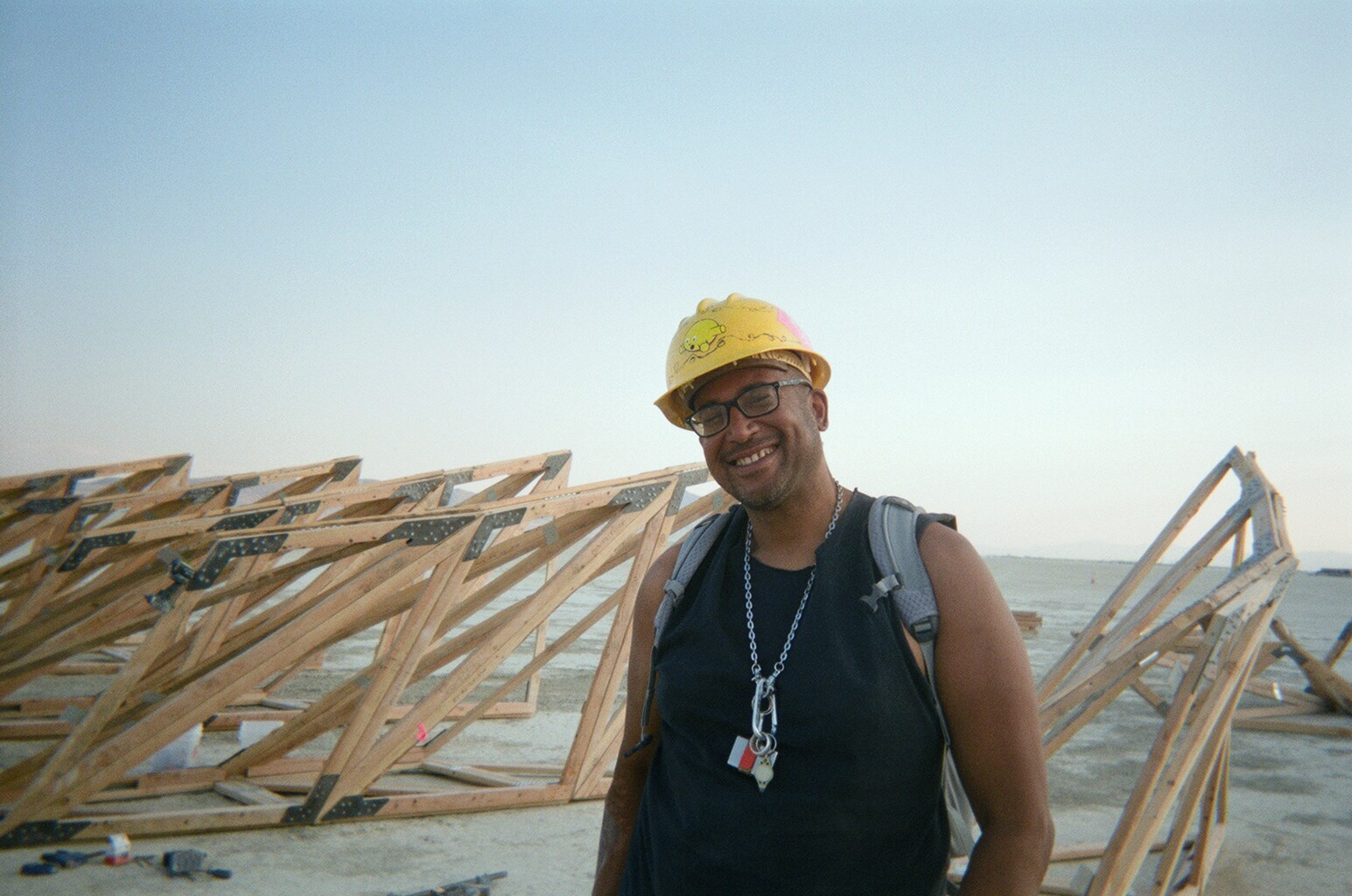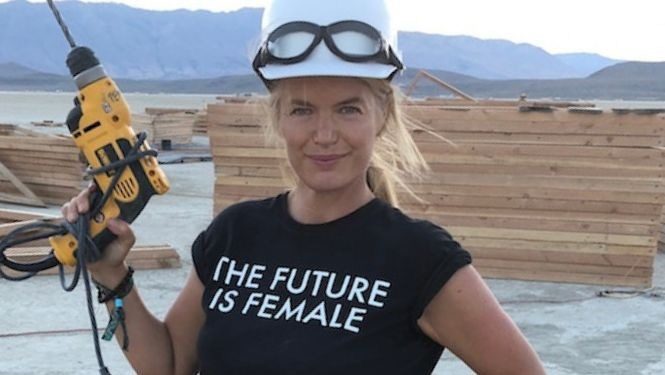It’s a two-day countdown to the global premiere of our documentary, “Burning Man: Art on Fire.” So far, the film is being well received. “An incredible representation of an indescribable event,” wrote one. As a longtime Burner and producer who spent more than two years bringing this dream to your screen, I hope you think it hits the spot.
Released on the Kindling portal this weekend, the film premiere will be a fundraiser for Burning Man Project, after which it goes out on general release. During Burn Week 2020, August 30 to September 6, you will also be able to watch the film inside the Galaxia Temple on the AltSpace platform in BRCvr, one of the eight Recognized Universes of the Burning Man Multiverse. I’m super excited about what may be the first-ever screening of a documentary feature film in Virtual Reality.
A Gender-Balanced International Crew
I wanted to share with you some of the stories behind the making of a freeform documentary on playa with no budget — a classic Burner move on my part. As a passionate advocate of equity and inclusion, it was important to me that the film represent gender balance and diversity on both sides of the camera. In true Burning Man spirit, the film brought creatives and volunteers together from all over the world. We had a Brit, a South African, a Russian, a New Zealander, a Mexican, and an American in our crew.
Given Burning Man’s demographics, on the other side of the camera gender balance was easier to accomplish than other forms of diversity. In 2018 when we filmed the documentary, fewer than 25% of participants identified themselves as people of color. Only 1% of participants at Burning Man identify as Black. Women are better represented in the film: Kate Raudenbush and Dana Albany are major characters, along with Dana’s partner, Flash Hopkins and the Burning Man base designer, Andrew Johnstone.
Director Gerry Fox and cinematographer Jonathan Clark worked their camera magic, gender-balanced by associate producer, Jennifer Raiser, and myself. Under Gerry’s guidance, much of the editing was done by a talented British film student, Una Burnand, a distant cousin of mine, while my niece, Serena Swire, supported the social media drive. The beautiful score was written and performed by a female composer, Hannae, and the film is represented by Ro*co Films’ Annie Roney, one of the world’s leading independent documentary film distributors.
Some Remarkable Collaborators
While we didn’t always achieve equity in what made it into the final cut of the documentary, we met and filmed some amazing people along the way. I thought I’d share a couple of them with you here. In late spring of 2018, I joined Arthur and his Australian-Chinese fiancé Sandy Kwan in San Francisco, where they hosted a fundraiser for the Temple in the Google headquarters. The event, Space Oddity, overlooked the Bay Bridge illuminated by Burner artist Leo Villareal, who is now lighting the bridges of the Thames in London. We interviewed a very worried Arthur on camera. He had underestimated material costs and needed an additional $100,000 or the Temple Galaxia wouldn’t proceed. At the eleventh hour, a generous Silicon Valley angel dug deep and the Temple was saved.
The following day, I was driven to Reno by Jocelyn, (aka Ambassador Joss) a charming, six-foot-two volunteer who was in the process of gender reassignment. Her car was broken into as we were about to leave, and vital designs and image assets for Galaxia were lost. We drove for six hours with plastic sheeting pinning the back of the car together. It sounded like a Burning Man tent in a hurricane.
Over the course of the ride, she offered a blow-by-blow account of her new life as a woman. “Ask me any question,” she said. And I did. As it grew dark, we stopped at a ropey looking roadside trucker cafe for a bathroom break. Some dodgy types were loitering. “Don’t worry,” she said, as we headed for the ladies’ room,” I can protect you. One of the advantages of being a tall trans is that I stand my ground. I don’t take any crap from anyone.”
A few weeks later, it was our first day on playa, a punishing, hot day in mid August. After we set up camp with the Galaxia crew, I spotted a tall, strapping, African-American man wearing a kilt and setting up his tent. I cheekily asked him if he was a true Scotsman. He introduced himself as Chocolate, otherwise known as Aaron Woods. “Aye,” he said in a dreadful impersonation of a Scottish accent. “My grandpa was a Johnstone, so I’m related to Haggis (Man Base designer Andrew Johnstone). And I’m descended from Mary Queen of Scots!”
“So am I!” I responded delightedly. We spent the next dusty few weeks fondly calling each other ‘Cuz’.

One day I asked Chocolate why he and the other volunteers gave up months of their lives every year to volunteer for the Temple build. “Freedom, adventure, DANGER!” he exclaimed. “Arthur has asked me to manage the strapping together of all the nodes. That means I have to get a team, make some friends and make it all happen!“ he said. “It’s arduous. Keeping my team engaged and working together is my biggest worry. We’re having to develop solutions to problems on the spot: like the metal brackets that hold the pods together cutting into the straps from the incredible weight of the structure — the straps that hold the entire thing together!” he reiterated, his head in his hands. “But there’s a synergy you get, working on something hard and meaningful with a group of people. That’s what I do it for. That and all the crazy-ass shit you get to do… weirdos you get to meet, and personas you get to inhabit,” he winked.
Another time I asked him, “Why are there so few people of color here, do you think?” He replied, “God. I get asked this a lot because I’m Black. The thing is that Burning Man doesn’t originate from Black culture. It originates from a culture in the default world that is made up of predominantly what you see on playa, which is mostly white people with a few people of color mixed in. And a whole lot of misfits, performers, builders and insane geniuses. Like you and me, Cuz,” he grinned.
I caught up with Ambassador Joss, who was commuting between Reno and Black Rock City, and asked her how it was going. “I’m trying to de-escalate things that are very upsetting to Arthur,” she responded, picking her words slowly and carefully. “I told Arthur that I am not a mental health professional. I’m the quartermaster, but I’m also trying to take care of interpersonal crew issues. There’s a fair amount of drama between crew people, as there always is.”
“I started my hormones the day after I drove you to Reno on April 1, which just happened to be April Fool’s Day”, she laughed. “By the time we were on playa I started to feel the effects.”
“How so?” I asked her.
“My capacity for listening and being empathetic has drastically skyrocketed, luckily. And the estrogen is starting to make my boobs grow,” she added.
A Temple Rises From the Dust
I asked Ambassador Joss how her experience as a volunteer on Galaxia had evolved. “The Temples I’ve worked on are like my children,” she said. “It’s almost like being a parent. Your blood, sweat and tears are literally a part of the Temple. All Temples are beautiful, complex structures that take more work than people can possibly imagine. For me, personally, Galaxia is a very profound experience. To be a part of something that is both architecture and art, that ultimately becomes the spiritual centre of Burning Man, on an ad hoc crew, working through the good days and the bad days. To see Arthur rise from an architect with a dream, to a leader who is forging a remarkable, immensely complex project is simply awe-inspiring.”
The Temple is brought to life from scratch each year. What appeared to be a simple, elegant, symmetrical design on Arthur’s London office computer all those months before, was incredibly difficult to build out of wood in the dry desert heat. But when it was built, it was breathtaking: completely and utterly magical. It took an army of builders, engineers, electricians and a ragtag crew of volunteers — including our film crew — working the hardest we had ever worked in our lives, to bring it to life.
The Temple build and Burn is the heart of our film. There are tears and there is laughter. When you watch it, you will participate in a wedding and in a funeral. Like the other volunteers, I felt an overwhelming sense of joy and sadness when it burned. But also a sense of release, because the project had reached completion.
Marking the Transition to a New Era, and a New Project
For me personally, the Temple Burn also marked the end of an era and the start of a new one. Once the summer is through, I’ll be launching a new investment platform inspired by Burning Man and by the circular economy. It will back diverse businesses with tech solutions for people, for the planet and for profit. After all, back here in the default world, the dollars we spend are the world’s most powerful force for change. Americans are the most generous people on the planet; they gave $400 billion to charity last year, but spent 325 times that buying stuff. If even a fraction of that can be spent backing companies with creative solutions to the global goals, the impact will be enormous.
The world premiere of “Burning Man: Art on Fire” is a fundraiser for Burning Man Project. In a modest way, it will help the organization bring you and this pioneering art back to Black Rock City next year. In the meantime, after months of isolation, doom and gloom, we hope the film will bring you much-needed joy and community. Let’s gather this weekend to celebrate the creativity, the fire and the flames that light our desert home. See you soon!
Join us August 15 and 16, 2020 for two online screenings of “Burning Man: Art on Fire” followed by a live Q&A with the artists and filmmakers. Showings are timed to be accessible in multiple time zones. Register to attend on Burning Man Project’s Kindling portal.


Might help for you to plug that tool in ;)
Report comment
I hope she didn’t hurt herself. Tools are symbols of toxic masculinity.
Report comment
Comments are closed.